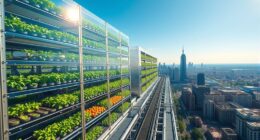Kinetic architecture involves buildings that adapt dynamically to environmental changes like weather and sunlight. You’ll find these structures use sensors and smart materials to move, reshape, or adjust transparency for ideal comfort and energy efficiency. These systems may include rotating facades, sliding walls, or shape-shifting elements that respond instantly to their surroundings. If you explore further, you’ll discover how these innovative designs are shaping the future of sustainable and responsive urban spaces.
Key Takeaways
- Kinetic architecture uses embedded sensors and smart materials to enable buildings to adapt their shape and function in response to weather conditions.
- Dynamic building elements like rotating facades and sliding walls adjust airflow, sunlight, and temperature for energy efficiency and occupant comfort.
- Advanced mechanisms and robotics allow structures to shift seamlessly, optimizing environmental performance during weather changes.
- Environmental responsiveness in kinetic buildings reduces energy consumption and enhances sustainability by adapting to natural climate variations.
- Iconic examples demonstrate how shape-shifting designs improve urban resilience, aesthetic appeal, and interaction with natural weather patterns.
The Science Behind Moving Structures

Have you ever wondered how structures can move and adapt in real time? It all comes down to sensor integration and material innovation. Sensors are embedded into building components, constantly monitoring environmental changes like wind, sunlight, or temperature. When these sensors detect a shift, they send signals that trigger mechanical adjustments, allowing the structure to respond instantly. Material innovation plays a pivotal role here, too—engineered materials can change shape, stiffness, or transparency based on stimuli, making buildings more responsive. These advancements create dynamic systems that don’t rely solely on traditional mechanical parts but instead leverage smart materials and sophisticated sensors. Additionally, water parks utilize advanced infrastructure and adaptive features to enhance visitor safety and enjoyment during varying weather conditions. The result? Structures that can shift, breathe, and adapt seamlessly, improving performance, safety, and energy efficiency.
Types of Kinetic Architectural Elements

Kinetic architectural elements come in various forms, each designed to enable buildings to move and adapt dynamically. You’ll find traditional materials like steel, glass, and wood combined with advanced mechanical systems to create these features. For example, rotating facades use motors and pulleys to open or close windows and panels, controlling light and airflow. Sliding walls and shifting roofs rely on mechanisms that glide smoothly, allowing spaces to transform instantly. Some kinetic elements incorporate simple hinges or joints, while others employ complex robotics. These systems are engineered for durability and precision, ensuring seamless movement. By integrating traditional materials with innovative mechanical systems, you can design buildings that respond intelligently to environmental changes, enhancing comfort and efficiency while maintaining structural integrity. Embrace Adventure in architecture by creating dynamic spaces that foster community interaction and adaptability.
Notable Examples of Dynamic Buildings

You’ll see how adaptive facades respond to environmental changes in buildings like the Al Bahr Towers. Iconic moving structures, such as the Beijing National Stadium, showcase innovative kinetics in architecture. These examples highlight how dynamic elements transform the way buildings interact with their surroundings. Modern appliances connection platforms also incorporate smart technology to enhance building functionality and energy efficiency.
Adaptive Facades in Action
Adaptive facades dynamically respond to environmental conditions, transforming the way buildings interact with their surroundings. You’ll notice how they seamlessly integrate solar technology to optimize energy use, adjusting angles or openings based on sunlight levels. These systems enhance environmental responsiveness by controlling heat gain, glare, and ventilation, reducing reliance on HVAC systems. For example, some buildings feature louvers that open or close in response to temperature sensors, maximizing passive cooling and daylighting. Others incorporate smart glass that shifts transparency depending on sunlight intensity. These innovations not only improve energy efficiency but also create more comfortable indoor environments. Additionally, the integration of natural materials in facade components helps buildings blend more harmoniously with their surroundings while promoting sustainability. As you observe these structures, you see how their kinetic elements actively adapt, making buildings more sustainable and attuned to their natural context.
Iconic Moving Structures
Have you ever marveled at buildings that seem to move or change shape? Iconic moving structures, like the Eden Project’s geodesic domes and the Dynamic Tower in Dubai, showcase how dynamic design can enhance aesthetics and functionality. These buildings often utilize sustainable materials, reducing environmental impact while maintaining durability. They also respect historic preservation by integrating innovative elements with existing structures, creating a dialogue between tradition and modernity. Such designs demonstrate how architecture can be both iconic and adaptive, capturing public imagination and pushing engineering boundaries. These structures not only serve practical purposes but also inspire future developments in kinetic architecture, proving that buildings can be more than static shells—they can actively respond to their environment while honoring their history. Incorporating environmentally responsive design principles allows these structures to dynamically adapt to weather conditions, further emphasizing their innovative nature.
Benefits of Adaptive Architecture

Did you know that adaptive architecture can remarkably enhance the functionality and sustainability of buildings? By adjusting to weather conditions and occupant needs, these structures improve energy efficiency, reducing heating and cooling costs. When elements like windows, walls, and shading devices shift in response to environmental changes, you experience more consistent occupant comfort without relying heavily on mechanical systems. This responsiveness minimizes energy waste and promotes eco-friendly design. Additionally, adaptive buildings create healthier, more pleasant environments by optimizing airflow, sunlight, and temperature. As a result, you benefit from lower utility bills and a reduced carbon footprint. Maximize Space and Organization Embracing this approach not only supports sustainability but also elevates your living or working experience through smarter, more intuitive architecture.
Challenges in Designing Shape-Shifting Structures

Designing shape-shifting structures presents significant challenges because creating mechanisms that reliably change form while maintaining stability and safety isn’t straightforward. One major concern is material durability; the materials used must withstand frequent movement, weather exposure, and stress without degrading. This requires selecting advanced, resilient materials that can endure repeated transformations. Additionally, these structures pose maintenance challenges, as complex moving parts demand regular inspection, lubrication, and repairs to ensure proper operation. Guaranteeing safety during transitions is critical, so engineers must design fail-safes and redundancies. Balancing flexibility with robustness complicates the design process, pushing the limits of current technology. Ultimately, overcoming these challenges requires innovative solutions, rigorous testing, and a keen focus on long-term performance to deliver reliable shape-shifting architecture. The integration of AI Security technologies can also enhance monitoring and predictive maintenance, ensuring safer operations over time.
Future Trends in Kinetic Design

As technology advances, the future of kinetic design is poised to become more integrated, responsive, and sustainable. Expect to see smart materials playing a key role, allowing buildings to adapt seamlessly to environmental changes without complex mechanisms. These materials can change shape or transparency, improving energy efficiency by optimizing natural light and ventilation. Kinetic structures will become smarter, using sensors and automation to respond instantly to weather conditions or occupant needs. This progress will lead to more energy-efficient buildings that reduce reliance on artificial heating, cooling, and lighting. You’ll notice designs that are not only functional but also environmentally friendly, pushing architecture toward a more sustainable future. Overall, kinetic design will evolve into a smarter, more eco-conscious approach to shaping our built environment. TikTok demonstrates how innovative platforms can popularize and inspire new design trends globally.
How Kinetic Architecture Impacts Urban Living

How does kinetic architecture transform urban living? It creates adaptable spaces that respond to weather and activity, reducing urban noise by shifting facades to block or open views as needed. These buildings enhance comfort and safety, making city environments more livable. Kinetic designs also influence construction materials, encouraging innovative, lightweight, and durable options that support movement and flexibility. As buildings shift, they can minimize noise pollution and improve air circulation, leading to healthier urban spaces. This dynamic approach fosters a more sustainable, responsive cityscape, where structures actively contribute to residents’ well-being. By integrating kinetic elements, urban areas become more efficient, resilient, and engaging, ultimately shaping a city that’s more harmonious with its inhabitants and environment. Additionally, incorporating projector technology into urban design can enhance public spaces, creating immersive environments that adapt to various activities and enhance community interaction.
Frequently Asked Questions
How Do Kinetic Buildings Affect Energy Consumption and Sustainability?
You might wonder how kinetic buildings influence energy efficiency and environmental impact. These structures adapt to weather conditions, reducing the need for heating, cooling, and artificial lighting. By shifting shapes or opening windows automatically, they minimize energy consumption and lower emissions. This dynamic approach promotes sustainability, helping you create a more environmentally friendly space while saving on energy costs, ultimately making your building more efficient and eco-conscious.
What Materials Are Most Suitable for Creating Durable Moving Architectural Components?
You should focus on smart material innovations like shape-memory alloys and flexible composites, which offer durability and adaptability. These materials provide the structural flexibility needed for moving architectural components that withstand weather and usage stresses. By choosing resilient, innovative materials, you guarantee longevity and performance, making your kinetic designs both functional and sustainable. This approach helps create dynamic buildings that adapt seamlessly while maintaining structural integrity.
How Do Weather Conditions Influence the Maintenance of Shape-Shifting Structures?
Weather woes worsen with time, so you must weigh weather conditions when maintaining shape-shifting structures. Constant climate changes demand diligent upkeep, as rain, wind, and temperature shifts threaten structural flexibility. You’ll need to regularly inspect, swiftly stabilize, and skillfully seal components to guarantee durability. Adapting to weather conditions keeps your kinetic creations resilient, allowing them to perform perfectly while weathering the elements with unwavering, unwavering willpower.
Are There Safety Concerns Associated With Dynamic Architectural Systems?
You should consider safety concerns with dynamic architectural systems because they impact structural integrity. If these systems malfunction or are poorly maintained, they could pose risks during extreme weather or emergencies. Always guarantee proper maintenance and have clear emergency protocols in place. Regular inspections help detect issues early, so you can address them before they compromise safety, ensuring the building remains secure regardless of its shape-shifting features.
Can Kinetic Architecture Be Integrated Into Existing Urban Infrastructure?
You can integrate kinetic architecture into existing urban infrastructure by focusing on adaptive facades that respond to environmental changes. This approach enhances urban integration, allowing buildings to adapt seamlessly to their surroundings. You’ll need to contemplate structural compatibility, energy efficiency, and aesthetics. By doing so, you create dynamic spaces that improve functionality and sustainability, making cities smarter and more responsive to weather and climate conditions.
Conclusion
Kinetic architecture is like a living organism, constantly adapting to its environment and shaping the city’s heartbeat. As you explore these dynamic structures, you see how they breathe, move, and respond, transforming urban spaces into responsive, vibrant ecosystems. Embracing this fluid design approach, you’re part of a future where buildings aren’t just static shells but active partners in daily life—resilient, innovative, and alive with possibility.










